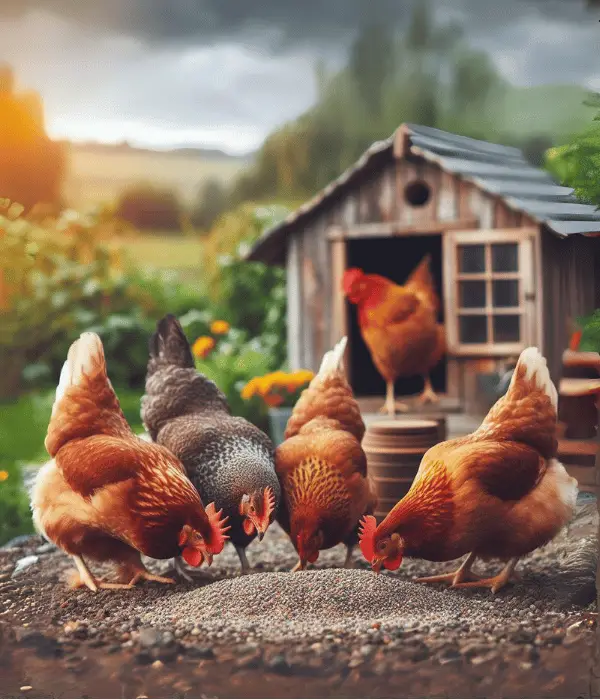Why is “grit for chickens” necessary for poultry health? It is essential to know about various things about chicken grit, like its importance, benefits, types, and feeding guide.
Some people confuse grit and oyster shells. Both are different things with different uses. We will also discuss that further.
Most of the people do not give grit to their chickens. Still, their chickens are healthy. So, why is grit given to chickens?
In this guide, you will understand whether your chickens need it. So, let’s start.
What Is Grit for Chickens?
Grit is ground hard stone in tiny pieces. It’s essential for chicken’s digestion. This helps to grind the food inside the chicken’s gizzard. Without grit, hens would have digestive issues.
Chickens can’t chew, as they don’t have teeth. They eat a large portion of food and greens that must be broken down. Grits help with that purpose.
When chickens eat grit, their gizzard’s muscles flex it to break the food into smaller pieces. This process helps the chicken’s body get the complete nutrients.
However, the free-ranging or foraging chickens will mostly get the grit from the backyard ground. It is primarily suitable for pets or chickens living inside the house.

The Importance of Grit in Poultry Health
Chickens eat small stones and gravel to grind food inside their gizzard. Then the food goes for further easy digestion.
Without teeth, chickens use a different digestive system to digest their food. The process begins in the chicken’s crop, a pouch-like throat that stores and moistens food.
The glandular and muscular stomach (gizzard) receives food and grit from the crop.
Strong muscles grind and crush food in the gizzard with the help of grits. Grit helps chickens break down hard and fibrous materials.
Also, chicken grit helps to grind grains and other rigid materials in the chicken’s gizzard, helping food break down mechanically.
A few key points about grit working in the chicken’s digestive system:
- Grit helps the gizzard mechanically break down food, exposing more surface area for digestive enzymes. The digestion and absorption of food nutrients depend on this mechanism.
- With grit, chickens may be able to grind hard food. Undigested complex food pieces can clog the digestive tract and cause obstruction.
- Proper gizzard grinding helps the intestines absorb feed nutrients properly. This helps chickens stay healthy.
- Chickens naturally forage for tiny stones and grit. Providing grit helps in natural behavior and matches their foraging behavior.
What is Grit for Chickens Made Of?
Grit for chickens is small, hard particles that help to break down food inside the gizzard. Two main kinds of grit exist: those that dissolve (soluble) and those that don’t (insoluble).
Chicken grit usually contains natural things that they can eat. Here is a thorough analysis of chicken grit components:
Insoluble Grit:
Insoluble grit for chickens is typically broken granite, flint, or tiny rocks. These materials are hard and resilient and help to grind grains and complex plant materials in the chicken’s gizzard.
The gizzard grinds continuously because insoluble grit stays there. It helps chickens digest hard seeds, cereals, food scraps, and other fibrous materials.
Soluble Grit:
Crushed oyster shells, limestone, or other calcium carbonate sources are a few examples of soluble grit for chickens. The materials are softer and dissolve faster.
Soluble grit offers helpful elements, including calcium, for eggshell production. It helps grind, but its primary purpose is to fulfill the calcium needs of chickens.
The best soluble grit for chickens is crushed oyster shells, which are slowly in their body with high efficacy, like extended-release tablets in humans.
Commercial Grit Blends:
Some commercial grit for chickens contains a combination of insoluble and soluble grit. Trace minerals and vitamins may boost the nutritional value of these mixes.
Commercial chicken grit combinations balance grinding abrasiveness with health-promoting minerals. The complete solution in one product makes them convenient for poultry owners.
Natural Source Grit:
Chickens may eat tiny stones, pebbles, and soil in nature. Allowing chickens to free-range in backyard chickens and forage naturally helps them to get grit from natural sources. It ensures they get the suitable grit for chickens’ gizzard function.
Poultry owners must choose grit according to the chicken’s age and needs. Young hens require smaller grit, whereas adults need larger.
The Role of Silica Grit and Calcium Grit in Poultry Health
Knowing how silica and calcium grit affect poultry health might help you make intelligent choices.
Insoluble silica or flint grit stays in the gizzard for a long time. Its hardness and long-term action make it ideal for grinding complex grains and seeds.
Give your chickens silica grit to improve digestion and maximize nutrient absorption.
Calcium grit helps poultry in two ways. It grinds food like other grits and provides calcium supplements to the chicken’s body.
Laying hens require lots of calcium to make strong eggshells. Lack of calcium in a hen’s diet can cause thin or soft eggshells to break and cause health problems.
Selecting the appropriate grit for your chickens goes beyond digestion. Meeting their nutritional needs and keeping them healthy and productive are equally important.
Baby Chick Starter Grit, Grower Grit, and Adult Chicken Grit
Giving chickens age-appropriate grit is like giving humans a balanced diet. Offering the proper nutrients in the right amounts at each life stage is more than just providing food.
Baby chicks need starter grit in the first weeks. This smaller, easier-to-swallow form helps baby chicks digest solid food. Similar to how infants start with pureed meals before solids.
Growing chicks have different dietary demands. They eat larger grains and harder-to-digest foods. At this point, switch to grower grit for chickens. Consider how teens need more complex carbohydrates and proteins to grow.
When chickens start laying eggs, their diet changes again. Hens need grit comprised of calcium and large-size grit for rooster’s healthy digestion.
Oyster shells like grit improve hen’s digestion and provide calcium for solid eggshells. Similar to how adults require more vitamins and minerals to stay healthy.
What Is Gastro Grit for Chickens?
Gastro grit for chickens helps their gizzards to digest food. It breaks down big food particles to improve nutritional absorption.
It also supplies minerals and nutrients for chicken digestion. Some brands provide gastro grits with a probiotic mixture.
DIY Homemade Grit for Chickens (Using Eggshells, Limestone Rocks, and Stones)

Making grit for chickens from eggshells, limestone rocks, and other stones is a great way to replenish calcium and grit.
A DIY guide for making homemade grit using these materials:
Materials required:
- Eggshells (Keep and clean eggshells. Egg whites and membranes should be removed)
- Limestone Rock (Collect clean limestone rocks)
- Other Gravels and Stones (Get many small, hard stones and gravels. Free them of pollutants)
- Supplies for cleaning: Scrubbing brush, mild detergent
- Stone crushing equipment: Hammer, pliers, and heavy gloves.
DIY Steps:
Preparing Eggshells: Dry eggshells entirely in the air-drier or use the oven. Smash eggshells into small pieces using a wooden hammer.
Cleaning Stones: To clean gathered stones, mainly limestone, use a brush, light detergent, and water. Properly rinse and air-dry.
Sort by Size: Sort stones and eggshells by size. Divide them by grit size with a mesh sieve or manually.
Crushing Method: Protect your hands with heavy gloves. A hammer or pliers can smash stones and eggshells into small pieces.
Aim for various particle sizes to meet chick and adult chicken demands. Baby chicks mainly need a powdered form of grit.
Quality Control: Regularly check crushed grit for sharp edges or wrong sizes. If you get one, use tools to smooth rough edges or crush them into smaller pieces.
Mixing Parts: Create a variety of grit combinations with crushed eggshells, limestone, and other stones. This mix contains calcium and other minerals.
Storage: Store homemade grit in a clean, dry container until use. Keep it cold and dry to prevent mold and bacteria.
It is better to store each type of grit in different containers to give them according to the chicken’s age, size, condition, and season.
Giving Chickens Grit: Start feeding your chickens homemade grit with their usual feed. Give them in a separate dispenser and ensure they can swallow and use the grit by watching their behavior.
Monitoring and Adjusting: Watch your chickens use the grit by watching them. Adjust size or hardness dependent on chicken age and observations.
Considerations: Advice from poultry experts or veterinarians can help you choose the right grit size and hardness for your flock.
You can also use oyster shells, but they are not recommended for baby chicks. Oyster shells can be given only to the hens which are laying eggs.
So, if you are raising chickens only for eggs and you have a large flock, then you can keep an extra bottle of crushed oyster shells for your egg-laying chickens.
How to Use a Grit Feeder or Dispenser?
Grit should be readily available to chickens. Place the grit dispenser near the regular chicken feed.
Fill the feeder or dispenser with the appropriate type of grit and see how your flock responds to it.
The stone and gravel grit is mainly needed for chickens living inside homes or closed environments. They forage very little, so they always need more natural grit.
The grit feeder or dispenser gadgets store and dispense grit, ensuring your chickens always have it. A grit dispenser is similar to a chicken feeder.
Wet grit can get clumped together and lose its effectiveness. So, always fill fresh grit according to your flock’s requirements.
The Ideal Grit Size for Optimal Poultry Health
The best size of chicken grit for mature chickens is 3mm to 5mm. The size is most important because it helps to digest the feed by crushing it inside the gizzard.
Removing all the sharp pieces if present in the grit mixture is essential. However, you can give different sizes of grit in one feeder.
After giving grit, it’s important to keep watching your birds to understand whether they are eating them or you need to replace them.
The most essential is finding the correct grit size according to the chickens’ age, size, and nutrition.
Conclusion: Do I Need Grit for Chickens?
Most of the chicken raisers ask whether they need grit for chickens or not. So the answer is yes, your chickens need it to digest food and obtain nutrients.
It is highly recommended for chickens living in closed environments and pet chickens. As they rarely forage, they require more grit in their gizzard, which causes digestive and other health issues.
Laying health needs calcium-containing grits, whereas non-laying hens, chicks, and roosters need insoluble grinding grits.
Now you know the significance of grit in chicken diets, which will help you care for your flock.
Always remember to choose the correct type and size of grit for your chickens’ age and needs, and always provide it.
Knowledge and care can keep your poultry birds healthy and happy. Grit is the foundation of chicken health and productivity.


